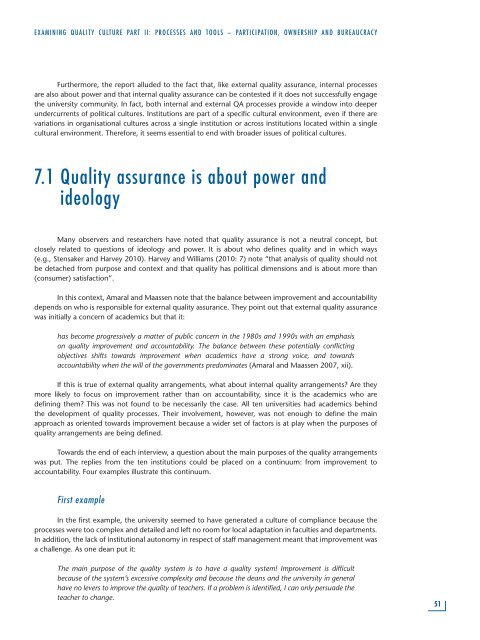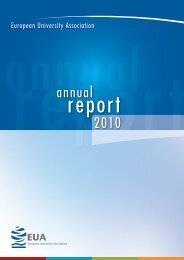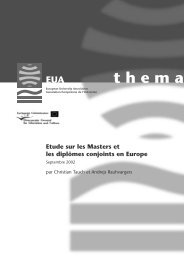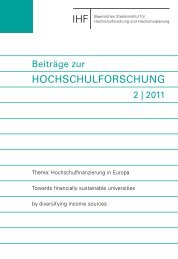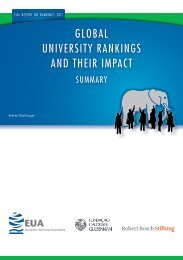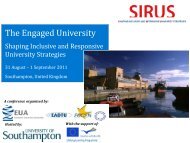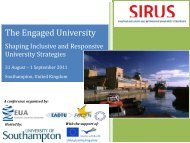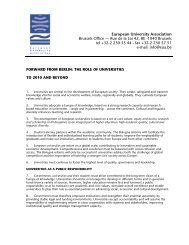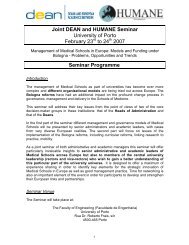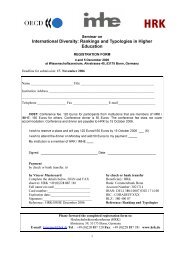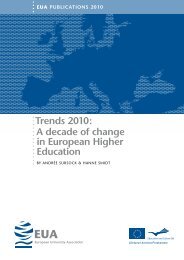Examining Quality Culture Part II: - European University Association
Examining Quality Culture Part II: - European University Association
Examining Quality Culture Part II: - European University Association
Create successful ePaper yourself
Turn your PDF publications into a flip-book with our unique Google optimized e-Paper software.
ExAmININg QUALITy CULTUrE PArT <strong>II</strong>: PrOCESSES ANd TOOLS – PArTICIPATION, OwNErShIP ANd BUrEAUCrACy<br />
Furthermore, the report alluded to the fact that, like external quality assurance, internal processes<br />
are also about power and that internal quality assurance can be contested if it does not successfully engage<br />
the university community. In fact, both internal and external QA processes provide a window into deeper<br />
undercurrents of political cultures. Institutions are part of a specific cultural environment, even if there are<br />
variations in organisational cultures across a single institution or across institutions located within a single<br />
cultural environment. Therefore, it seems essential to end with broader issues of political cultures.<br />
7.1 <strong>Quality</strong> assurance is about power and<br />
ideology<br />
Many observers and researchers have noted that quality assurance is not a neutral concept, but<br />
closely related to questions of ideology and power. It is about who defines quality and in which ways<br />
(e.g., Stensaker and Harvey 2010). Harvey and Williams (2010: 7) note “that analysis of quality should not<br />
be detached from purpose and context and that quality has political dimensions and is about more than<br />
(consumer) satisfaction”.<br />
In this context, Amaral and Maassen note that the balance between improvement and accountability<br />
depends on who is responsible for external quality assurance. They point out that external quality assurance<br />
was initially a concern of academics but that it:<br />
has become progressively a matter of public concern in the 1980s and 1990s with an emphasis<br />
on quality improvement and accountability. The balance between these potentially conflicting<br />
objectives shifts towards improvement when academics have a strong voice, and towards<br />
accountability when the will of the governments predominates (Amaral and Maassen 2007, xii).<br />
If this is true of external quality arrangements, what about internal quality arrangements? Are they<br />
more likely to focus on improvement rather than on accountability, since it is the academics who are<br />
defining them? This was not found to be necessarily the case. All ten universities had academics behind<br />
the development of quality processes. Their involvement, however, was not enough to define the main<br />
approach as oriented towards improvement because a wider set of factors is at play when the purposes of<br />
quality arrangements are being defined.<br />
Towards the end of each interview, a question about the main purposes of the quality arrangements<br />
was put. The replies from the ten institutions could be placed on a continuum: from improvement to<br />
accountability. Four examples illustrate this continuum.<br />
First example<br />
In the first example, the university seemed to have generated a culture of compliance because the<br />
processes were too complex and detailed and left no room for local adaptation in faculties and departments.<br />
In addition, the lack of institutional autonomy in respect of staff management meant that improvement was<br />
a challenge. As one dean put it:<br />
The main purpose of the quality system is to have a quality system! Improvement is difficult<br />
because of the system’s excessive complexity and because the deans and the university in general<br />
have no levers to improve the quality of teachers. If a problem is identified, I can only persuade the<br />
teacher to change.<br />
51


